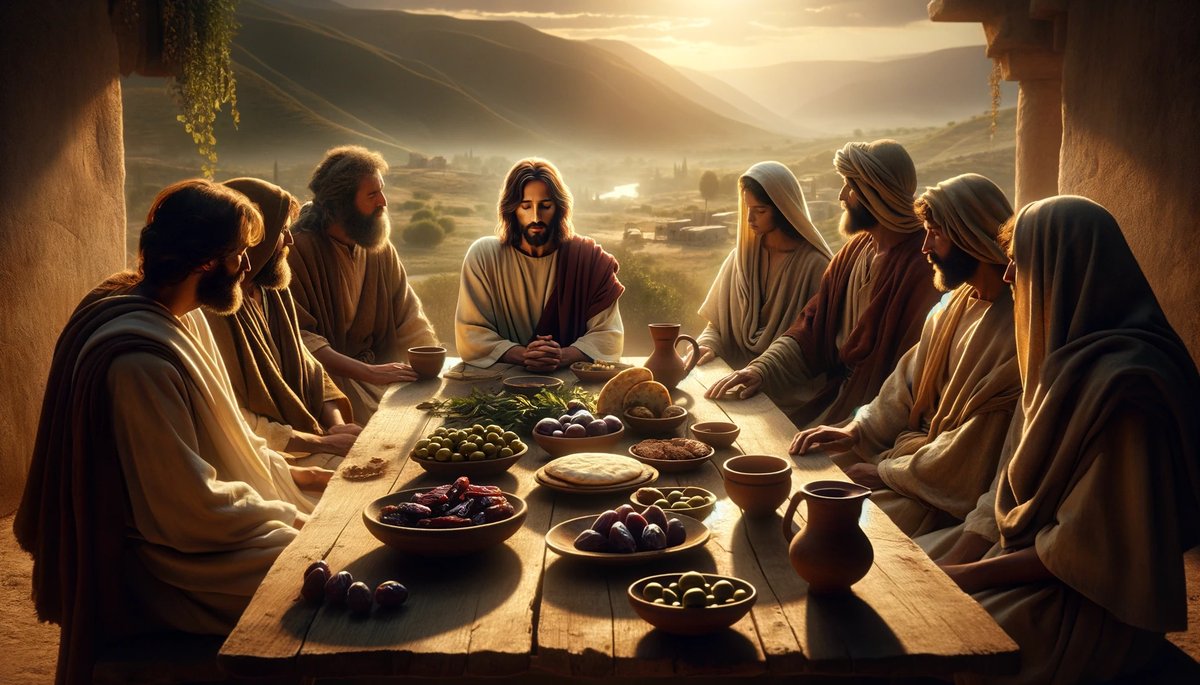Home>Christian Videos>Bible Stories>What Foods Did Jesus Christ Eat


Bible Stories
What Foods Did Jesus Christ Eat
Published: March 2, 2024
Ericka Andersen, an editor at Christian.net, expertly merges digital strategy with content creation, focusing on faith and societal issues. Her communication skills enhance the platform's engaging narratives, fostering meaningful dialogue on belief's impact on society.
Discover the biblical foods Jesus Christ ate and their significance in Bible stories. Explore the historical diet of Jesus and its spiritual importance. Unlock the secrets of ancient cuisine.
(Many of the links in this article redirect to a specific reviewed product. Your purchase of these products through affiliate links helps to generate commission for Christian.net, at no extra cost. Learn more)
Table of Contents
Introduction
What Foods Did Jesus Christ Eat?
Have you ever wondered what kind of foods Jesus Christ ate during his time on Earth? The diet of ancient Israel, particularly during the time of Jesus, was influenced by various factors such as cultural practices, religious beliefs, and the availability of resources. Exploring the foods that were common in Jesus' time can provide valuable insights into the daily life and customs of that era. Let's delve into the culinary world of ancient Israel and discover the foods that may have been part of Jesus' diet.
Read more: What Did Jesus Want To Eat With The Apostles
The Diet of Ancient Israel
The diet of ancient Israel was heavily influenced by the region's agricultural practices and the availability of natural resources. The people of ancient Israel primarily consumed a diet based on locally grown produce, including grains, fruits, vegetables, and dairy products. The agricultural landscape of ancient Israel was characterized by the cultivation of wheat, barley, olives, grapes, and figs. These staple crops formed the foundation of the ancient Israelite diet and were used to create a variety of dishes that sustained the population.
The ancient Israelites also relied on the consumption of meat, particularly from domesticated animals such as sheep, goats, and cattle. The practice of animal husbandry was integral to the economy and food supply of ancient Israel, providing a source of protein and sustenance for the people. Additionally, the consumption of fish, particularly in regions near the Sea of Galilee and the Mediterranean coast, contributed to the dietary diversity of the ancient Israelites.
The dietary laws outlined in the Hebrew Bible, particularly in the books of Leviticus and Deuteronomy, also played a significant role in shaping the eating habits of the ancient Israelites. These laws, known as kosher dietary laws, prescribed specific guidelines for food preparation and consumption, including the prohibition of certain foods such as pork and shellfish. Adhering to these dietary laws was a fundamental aspect of religious observance and cultural identity for the ancient Israelites.
Overall, the diet of ancient Israel was characterized by a reliance on locally sourced produce, the practice of animal husbandry, and adherence to religious dietary laws. These factors collectively shaped the culinary traditions of the ancient Israelites and likely influenced the foods that were commonly consumed during the time of Jesus Christ.
Common Foods in Jesus' Time
-
Grains: Grains such as wheat and barley were dietary staples during Jesus' time. These grains were used to make bread, a fundamental component of the ancient Israelite diet. Bread held significant cultural and religious symbolism, and it was a ubiquitous presence at meals and gatherings.
-
Fish: The consumption of fish was widespread, particularly in regions near bodies of water such as the Sea of Galilee and the Jordan River. Fish provided a valuable source of protein and nutrients, and it featured prominently in the diet of the people living in these areas.
-
Fruits: Fruits such as olives, grapes, figs, dates, and pomegranates were commonly consumed in ancient Israel. These fruits were not only enjoyed fresh but were also used in various culinary preparations and as sweeteners for dishes.
-
Vegetables: Common vegetables included legumes, lentils, onions, garlic, and cucumbers. These vegetables were used in a wide range of dishes and added essential nutrients and flavors to the ancient Israelite diet.
-
Dairy Products: Dairy products, including milk, cheese, and yogurt, were part of the diet, particularly among pastoral communities. These products provided a source of calcium and protein for the ancient Israelites.
-
Honey: Honey was used as a sweetener and was highly prized for its natural sweetness. It was used in cooking and baking, adding flavor to various dishes and desserts.
-
Nuts and Seeds: Almonds, pistachios, and sesame seeds were commonly consumed and were used in both savory and sweet dishes, adding texture and nutritional value to the ancient Israelite diet.
-
Herbs and Spices: Herbs such as mint, dill, and cumin, as well as spices like cinnamon and saffron, were used to season and enhance the flavors of dishes, contributing to the rich and diverse culinary heritage of ancient Israel.
The consumption of these common foods provides valuable insights into the dietary habits and culinary traditions of Jesus' time, offering a glimpse into the everyday meals and customs of the ancient Israelites.
The Importance of Bread and Fish
Bread and fish held profound significance in the diet and cultural practices of ancient Israel, playing pivotal roles in the daily lives of the people, including Jesus Christ.
Bread: A Symbol of Sustenance and Community
Bread was a symbol of sustenance and community in ancient Israel. It was a dietary staple, made from locally cultivated grains such as wheat and barley. The process of bread-making was deeply ingrained in the cultural fabric, with communal ovens being a common sight in villages and towns. The act of breaking bread held immense social and religious significance, symbolizing unity, hospitality, and shared nourishment. Bread was not merely a source of physical sustenance but also a representation of communal bonds and spiritual nourishment.
Read more: What Did Jesus Christ Preach
Fish: A Source of Nourishment and Symbolism
The consumption of fish, particularly in regions near bodies of water, was a vital source of nourishment for the ancient Israelites. The Sea of Galilee, in particular, was renowned for its abundant fish population, and fishing was a prominent occupation in the region. Fish provided a valuable source of protein and essential nutrients, contributing to the overall dietary diversity of the people. Moreover, fish held symbolic significance in the teachings and parables of Jesus Christ, with references to fish and fishing serving as metaphors for spiritual teachings and the calling of his disciples.
The Significance in Jesus' Ministry
The importance of bread and fish is underscored in several accounts of Jesus' ministry, where these elements feature prominently in his teachings and miracles. The miraculous feeding of the multitude, often referred to as the Feeding of the 5,000, exemplifies the symbolic and practical significance of bread and fish. This profound event, recorded in the Gospels, not only demonstrates Jesus' compassion and divine power but also underscores the themes of abundance, provision, and the spiritual nourishment offered through his teachings.
In essence, bread and fish were not only essential components of the ancient Israelite diet but also held deep symbolic and cultural significance, permeating various aspects of daily life, communal gatherings, and spiritual teachings. Understanding the importance of these dietary elements provides valuable insights into the cultural and religious context of Jesus' time.
Fruits and Vegetables in Jesus' Diet
During Jesus' time, a variety of fruits and vegetables formed an integral part of the diet of the ancient Israelites, contributing to their nutritional intake and culinary practices.
Fruits: Nature's Bounty
Fruits such as olives, grapes, figs, dates, and pomegranates were abundant in the region and held significant importance in the daily lives of the people. These fruits were enjoyed fresh and were also used in various culinary preparations. Olives, in particular, were a versatile fruit, providing not only sustenance but also yielding oil, a valuable commodity used for cooking, lighting, and anointing. Grapes were not only consumed as a fruit but were also used in winemaking, a practice deeply embedded in the cultural and religious traditions of the ancient Israelites. Figs and dates provided natural sweetness and were used as ingredients in a range of dishes, while pomegranates were prized for their vibrant seeds and juice, adding color and flavor to both savory and sweet creations.
Read more: What Foods Did The Apostles Eat?
Vegetables: Nourishing and Versatile
Common vegetables in Jesus' diet included legumes, lentils, onions, garlic, and cucumbers, among others. These vegetables were not only sources of essential nutrients but also added depth and flavor to the ancient Israelite cuisine. Legumes and lentils, rich in protein and fiber, were staple ingredients in hearty stews and soups, providing sustenance and nourishment. Onions and garlic were widely used as aromatic flavor enhancers, while cucumbers offered a refreshing and hydrating element to meals, particularly in the warm climate of the region.
The consumption of these fruits and vegetables not only contributed to the dietary diversity of the ancient Israelites but also reflected the rich agricultural heritage and natural abundance of the land. These natural bounties were celebrated in various cultural and religious contexts, symbolizing fertility, prosperity, and the blessings of the land. Understanding the role of fruits and vegetables in Jesus' diet provides valuable insights into the culinary customs, nutritional practices, and cultural significance of these natural gifts in the ancient Israelite society.
The Role of Wine in Jesus' Culture
Wine held a central and multifaceted role in the culture and traditions of ancient Israel, including during the time of Jesus. Its significance extended beyond mere consumption, encompassing social, religious, and symbolic dimensions that permeated various aspects of daily life and communal gatherings.
Cultural and Social Significance
Wine was deeply intertwined with the social fabric of ancient Israelite society, playing a pivotal role in communal feasts, celebrations, and gatherings. It was a symbol of joy, abundance, and hospitality, often featured prominently in festive occasions and communal meals. The sharing of wine fostered a sense of camaraderie and conviviality, enhancing the communal experience and strengthening social bonds. Wine was a tangible expression of the region's agricultural bounty and was esteemed for its ability to elevate ordinary moments into occasions of shared merriment and fellowship.
Religious and Symbolic Importance
In addition to its social significance, wine held profound religious and symbolic importance in the cultural practices of ancient Israel. It featured prominently in religious rituals, including sacrificial offerings and libations, symbolizing the pouring out of gratitude and reverence. Wine was also associated with the concept of abundance and blessings, often cited in prophetic imagery as a representation of divine favor and prosperity. Moreover, the symbolism of wine was intricately linked to the spiritual teachings of Jesus Christ, with references to wine and vineyards serving as metaphors for spiritual truths and the kingdom of God.
Read more: What Did Jesus Christ Do For Us
Culinary and Medicinal Uses
Beyond its symbolic and social roles, wine was a staple component of the ancient Israelite diet, providing hydration, nourishment, and flavor to meals. It was commonly diluted with water and served alongside bread and other food items. Additionally, wine was recognized for its medicinal properties and was used for its perceived health benefits, particularly in the context of ancient healing practices.
Understanding the multifaceted role of wine in Jesus' culture offers valuable insights into the interconnectedness of social, religious, and culinary aspects of ancient Israelite society. The cultural significance of wine underscores its pervasive presence in the daily lives, traditions, and spiritual teachings of the people during the time of Jesus.
Conclusion
In conclusion, exploring the foods that were part of Jesus Christ's diet provides valuable insights into the culinary customs, cultural practices, and religious traditions of ancient Israel. The diet of ancient Israel was characterized by a rich tapestry of locally sourced produce, including grains, fruits, vegetables, dairy products, and fish, all of which played integral roles in sustaining the population and shaping their way of life. Bread and fish held profound symbolic and practical significance, reflecting themes of communal nourishment, abundance, and spiritual teachings. Fruits and vegetables showcased the natural bounties of the land, celebrating fertility, prosperity, and the blessings of the region's agricultural heritage. Additionally, the multifaceted role of wine in ancient Israelite culture underscored its social, religious, and culinary importance, permeating various aspects of daily life and communal gatherings. Understanding the foods that were part of Jesus' diet not only provides a glimpse into the everyday meals and customs of the ancient Israelites but also enriches our appreciation of the cultural and historical context in which Jesus lived and shared his teachings.












